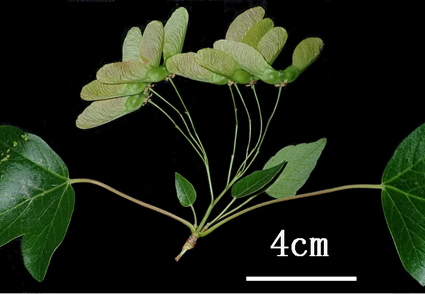Abstract
The floral characters of Acer yui are supplemented based on living plants flowering in April from the type locality. It is distinguishable based on both vegetative and floral characters between the two morphologically similar species, A. buergerianum and A. yui. Contrary to general consideration that the holotype is at PE, A. yui did not have a holotype designated when being described. It was later inadvertently lectotypified by Fang in 1939 and the single specimen traced meets that designation should be the lectotype, and the other duplicates are isolectotypes.
References
Ackerly, D.D. & Donoghue, M.J. (1998) Leaf size, sapling allometry, and corner’s rules: phylogeny and correlated evolution in maples. American Naturalist 52: 767–791. https://doi.org/10.1086/286208
Anonymous (1947) Commemoration Volume: In commemoration of Dr. Fang Wen-Pei’s ten years service in the National Szechwan University. The Commemoration Committee of friends of Dr. Fang Wen-Pei in the National Szechwan University, Chengdu, 32 pp.
APG (Angiosperm Phylogeny Group) (2016) An update of the Angiosperm Phylogeny Group classification for the orders and families of flowering plants: APG IV. Botanical Journal of the Linnean Society 181: 1–20. https://doi.org/10.1111/boj.12385
Chen, F. & He, H. (2022) The historical relic in Chongqing Natural History Museum: An annotated checklist of original materials for 37 names of Chines seed plants. Phytotaxa 530: 38–52. https://doi.org/10.11646/phytotaxa.530.1.3
Crowley, D., Barstow, M., Rivers, M. & Harvey-Brown, Y. (2020) The Red List of Acer, revised & extended. BGCI, Richmond, UK, 52 pp.
Fang, W.P. (1934) A new species of Acer from Szechua. Contribution from the Biological Laboratory of the Science Society of China, Botanical Series 9: 235–237.
Fang, W.P. (1939) A monograph of Chinese Aceraceae. Contributions from the Biological Laboratory of the Science Society of China, Botanical Series 11 (1–3): 1–346.
Fang, W.P. (1979) Praecursores florae aceracearum sinesium. Acta Phytotaxonomica Sinica 17: 60–86.
Fang, W.P. (1981) Aceraceae. In: Fang, W.P. (Ed.) Flora Reipublicae Popularis Sinicae, vol. 46. Science Press, Beijing, pp. 66–273.
Fang, W.P. & Wu, Y.T. (1981) Aceraceae. In: Fang, W.P. (Ed.) Flora Sichuanica, vol. 1. Sichuan People’s Publishing House, Chengdu, pp. 156–229.
Hou, J. (2012) Research Institute of West China Academy of Sciences. Central Party Literature Press, Beijing, 295 pp.
IUCN Standards and Petitions Committee (2019) Guidelines for Using the IUCN Red List Categories and Criteria, version 14. Available from: http://www.iucnredlist.org/documents/RedListGuidelines.pdf (Accessed 24 January 2022).
Lin, Q., Yang, Z.R. & Lin, Y. (2018) Type Specimens in China National Herbarium (PE), vol. 11 (Angiospermae 8). Henan Science and Technology Press, Zhengzhou, 598 pp.
Linnaeus, C. (1753) Species Plantarum, vols 1–2. Imprensis Laurentii Salvii, Holmiae, 1200 pp.
Miquel, F.A.W. (1865) Prolusio florae Japonicae. Annales Musei Botanici Lugduno-Batavi 2: 69–212.
Murray, E.A. (1982) Infrageneric taxa in Acer (Aceraceae). Kalmia 12: 2–28.
Suh, Y.B., Heo, K. & Park, C.W. (2000) Phylogenetic relationships of maples (Acer L.; Aceraceae) implied by nuclear ribosomal ITS sequences. Journal of Plant Research 113: 193–202. https://doi.org/10.1007/PL00013914
Thiers, B. (2022+ [continuously updated]) Index Herbariorum: a global directory of public herbaria and associated staff. New York Botanical Garden’s Virtual Herbarium. Available from: http://sweetgum.nybg.org/science/ih (accessed 20 January 2022)
Turland, N.J., Wiersema, J.H., Barrie, F.R., Greuter, W., Hawksworth, D.L., Herendeen, P.S., Knapp, S., Kusber, W.-H., Li, D.-Z., Marhold, K., May, T.W., McNeill, J., Monro, A.M., Prado, J., Price, M.J. & Smith, G.F. (2018) International Code of Nomenclature for algae, fungi, and plants (Shenzhen Code) adopted by the Nineteenth International Botanical Congress Shenzhen, China, July 2017. Regnum Vegetabile 159. Koeltz Botanical Books, Glashütten. https://doi.org/10.12705/Code.2018
Xu, T.Z. (1996) A new system of the genus Acer. Acta Botanica Yunnanica 18: 277–292.
Xu, T.Z. (1998) The systematic evolution and distribution of the genus Acer. Acta Botanica Yunnanica 20: 383–393.
Xu, T Z, Chen, Y S, de Jong, P.C, Oterdoom, H.J. & Chang, C.S. (2008) Aceraceae. In: Wu, Z.Y., Raven, P.H. & Hong, D.Y. (Eds.) Flora of China, vol.11. Science Press, Beijing & Missouri Botanical Garden Press, St. Louis, pp. 515–553.


